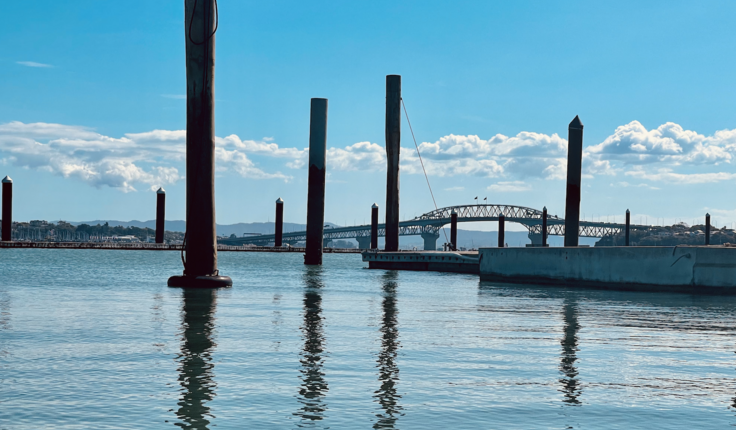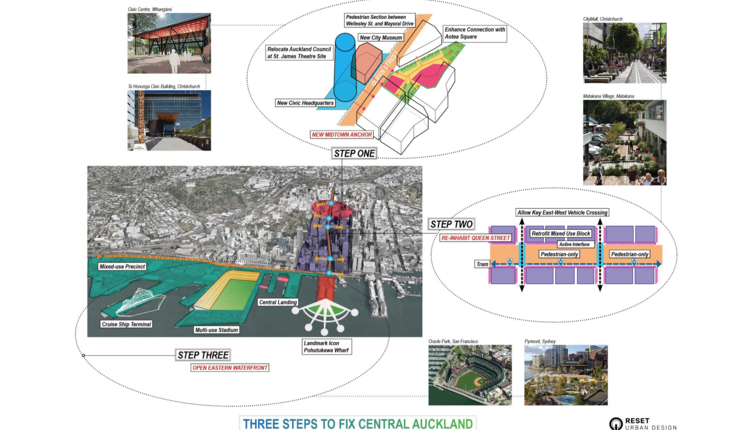News
Turning the pandemic into Auckland's silver bullet
Posted 09 08 2022 by Garth Falconer
in News

When it comes to Downtown Auckland’s future, we have to ask ourselves have we got what it takes to make a great city by conscious design, rather than expecting delivery from a collision of market forces, short term political cycles, no rate increase mandates, a lack of central government in regional strategy, the risk averse environmental planning and a persistent “yeoman” farmer mentality.
The recent one-off initiatives of the Regional Development Fund, Americas Cup and Special Housing Areas indicate such strategic shortcomings can be overcome by a concerted effort.
The pandemic has caught Downtown Auckland in a struggle to establish public transport, develop a residential population, stage mega events and make compelling places. Make no mistake, the exodus is seriously big with pre-Covid figures of around 90,000 office workers and 60,000 students a day dropping by at least 30 to 50 percent.
Whilst this sudden social change doesn’t necessarily spell the end of such urban centres where extremely high levels of gathering and activity help support the nation’s economy and culture, Downtown needs to adapt to retain gravity and quickly.
The calls for the pedestrianisation of Queen Street to bring people back has been a recurrent go to solution for decades, even going back to the 1926 design competition for a civic centre in upper Queen Street as the waterfront became industrialised.
For sure Queen Street is centrally important to Auckland’s Downtown, as it is a physically well-defined spine that ties and links in the whole inner city over what is difficult hilly terrain.
But the future of Downtown has to deal with a raft of major constraints, such as: a dominance of office space; competition from Wynyard Quarter; and the demands of a cross town movement network.
Against such heavy hitters, the continuing instalments of the 2012 central city masterplan or the soon to be started upgrade of Queen Street to form a shared path and busway can only be regarded now as lightweight contenders.

Fundamentally, Queen Street lacks the necessary winning equation of large numbers of people 24/7, along a wide path connecting to two anchors or destinations.
As several commentators have pointed out there are educative precedents of busy pedestrian main streets in other cities such as Barcelona’s Las Ramblas or Sydney’s George Street. Apart from supplying examples of robust fitouts, what these also point to are the importance of having two anchors at either end. In the case of Las Ramblas its Plaça de Catalunya the cities main square, at one end connecting to its celebrated waterfront, and with George Street, it is the rail station at one end and the concentrated collection of the super elements (namely the harbour bridge and the Opera House) around the cove at the other.
We can start to turn this equation in Auckland’s Downtown favour by thinking boldly – and maybe it’s only three steps away.
Step One: Midtown anchor. Mid-Queen St has been hit hardest with the student exodus, and this is where there needs to be a really strong anchor as the uptown barbell of Queen Street. The gamechanger here is to move Auckland Council back into the Aotea Precinct from its embattled Albert Street premises. Imagine on the site of the now demolished St James Theatre site, a new purpose-built civic headquarters complete with large video screens together with a city museum, opening out onto larger Aotea Square that spilled out onto Queen Street.
Step Two: Re-colonise Queen Street. The upgrade which is about to start is a half measure, as buses and people are not the ideal mix. Instead create a series of broad pedestrian only segments up the blocks of Queen street whilst allowing cross traffic at Mayoral Drive, Wellesley, Victoria and Customs Streets. This would be a wide clearway of large-scale elements (detail could be set in warm coloured paving, with a great light show and abstract river motifs). In tandem, there has to be massive adaptation of office buildings; rents need to be incentivised, premises improved and many converted in their use.
Step Three: The big idea is that Downtown Auckland is the centre of the glorious Waitemata harbour but it is currently half open at best. There needs to be a bigger wider connection with its “raison d’etre” to the east. Firstly, with the Admiralty steps (which were promised eight years ago in lieu of the loss of QE Square) and the start of the transition to decamping the Port of Auckland to somewhere else - hopefully to a place with nationally strategic benefits. Secondly, invest in a multi-use state of the art sports stadium (see the 42,000 seat Oracle Park in central waterfront San Francisco), which would anchor a substantial new mixed-use quarter that would boost the Downtown catchment past its tentative status.
The big picture is that in the information age, the long-term drivers of dispersal are ascending those of concentration. Online retailing and remote learning and working are just the latest of in a series of spatial liberalisations that have accelerated the morphing of city form to spreading suburbs, multiple centres and nearby urban conglomerations. What we need in catch up cities like Auckland is for our designs to direct the outcomes we want.
Garth Falconer is the Director of Reset Urban Design, author of Living in Paradox (2015) and Harry Turbott: New Zealand’s first landscape architect (2020).
Share
19 Dec
Christmas break 2025

see you from 12 January
As we wrap up another big year, we’re taking a moment to pause, breathe, and enjoy a well-earned break. Meri …
18 Dec
President’s update

December 2025
Earlier this month I attended the Ngā Aho Māori Design Professionals Wānanga-ā-Tau at Te Aranga Marae in Flaxmere. Tuia Pito …
18 Dec
Awards 2026 update

An update as we warm up for the 2026 Awards kaupapa. Submissions will open in March and will run for …
Events calendar
Full 2025 calendar